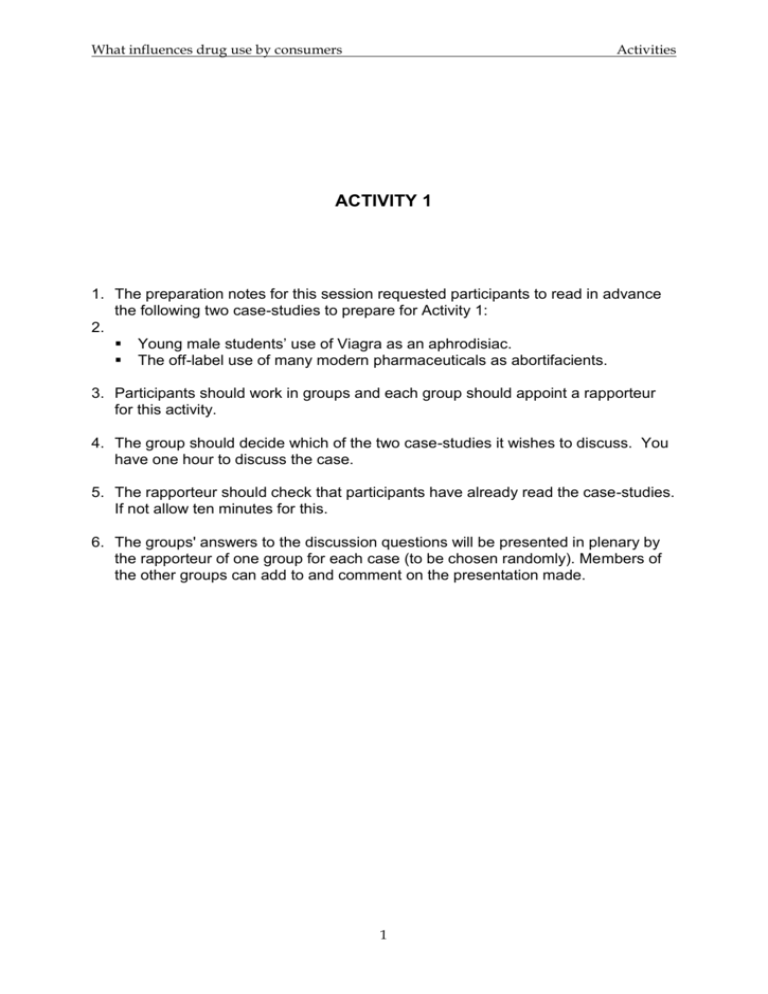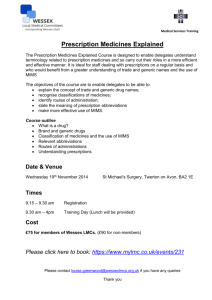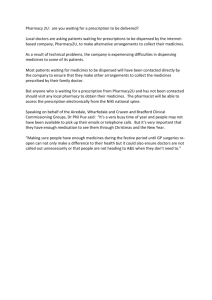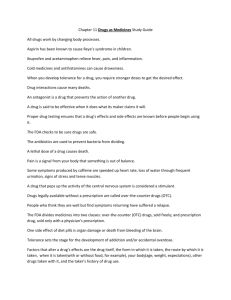Activities_WhatInfluencesDrugUse
advertisement

What influences drug use by consumers Activities ACTIVITY 1 1. The preparation notes for this session requested participants to read in advance the following two case-studies to prepare for Activity 1: 2. Young male students’ use of Viagra as an aphrodisiac. The off-label use of many modern pharmaceuticals as abortifacients. 3. Participants should work in groups and each group should appoint a rapporteur for this activity. 4. The group should decide which of the two case-studies it wishes to discuss. You have one hour to discuss the case. 5. The rapporteur should check that participants have already read the case-studies. If not allow ten minutes for this. 6. The groups' answers to the discussion questions will be presented in plenary by the rapporteur of one group for each case (to be chosen randomly). Members of the other groups can add to and comment on the presentation made. 1 What influences drug use by consumers Activities Case-Study I: Direct-to-Consumer Advertising of Prescription Drugs Most countries do not allow advertising or promotion for prescription drugs directly to consumers. In recent years, such regulations have come under challenge as drug companies argue that consumers are entitled to information about new prescription drugs. In the United States and New Zealand, this has resulted in the repeal of a ban on direct-to-consumer advertising (DTCA). As a result, printed periodicals sometimes contain more prescription-drug ads than over-the-counter medicine promotion. For example, a recent issue of the US magazine Life (March 2000) contained ads for nine prescription drugs filling 18 pages. It contained no ads for over-the-counter drugs. Typically, the drug ads comprised at least two pages. This is mainly because they included additional information on the drugs presented in a question-and-answer format, for example: “Can I take other medications with Tamiflu?” All the ads included telephone numbers and website addresses for readers wanting additional information. Even with the extensive information they contained, these DTC ads for prescription drugs cause concern. This is mostly due to the large volume of advertising for a new category of pharmaceuticals called ‘lifestyle’ drugs. These medicines are promoted for indications such as ‘erectile dysfunction’ and ‘social anxiety’. Critics suggest that promotion of such drugs will lead to increased medicalisation of conditions that are not real health problems or that may be responsive to non-drug interventions. The problems caused by DTC promotion of prescription drugs become more acute in developing countries. Below are two examples from the Philippines, where two prescription drugs – orlistat (Xenical), for obesity, and sidenafil citrate (Viagra), for male sexual dysfunction – were recently launched and heavily promoted. Viagra Promotion of Viagra started before the drug was even approved. One newspaper featured a seven-part article on the drug in May 1999. This was about five months before it gained approval. The title of the first article in the series declared “3.5 million Filipinos are impotent”. This estimate was given by a Filipino urologist working on the drug manufacturer’s clinical trials. The Filipino doctor based his projections on the US Massachusetts Male Ageing Study that was conducted from 1987 to 1989. Another article in the series announced “My husband is like Superman”, a quote supposedly from a Filipino whose husband had taken the drug. 2 What influences drug use by consumers Activities An organisation called the Philippine Erectile Dysfunction Research Organization (PIDRO) a play on a local slang term for the penis suddenly appeared, comprised of Filipino doctors endorsing Viagra. Its members were interviewed for numerous newspaper stories and appeared on television. In almost all cases, the doctors promoted Viagra as an aphrodisiac. Few doctors referred to the drug’s risks although newspapers eventually began picking up foreign reports of men with heart conditions dying after using Viagra. Unsurprisingly, when the drug finally entered the market, there was initial demand for it as an aphrodisiac. Young male college students began taking it just to see if it would improve sexual performance. After its approval, ads appeared regularly in newspapers with teasers such as “Do you know Ed?” (Ed being erectile disorder). They included some information on the causes of erectile dysfunction and a phone number to call. However, the drug’s name was not mentioned as Filipino law still bans DTC advertising. Regardless, the fact that the ads mention the company’s name already hints at what product is being promoted. Xenical Xenical’s promotion started only after the drug was approved. Like Viagra, the campaign began with newspaper articles talking about a problem: “One in every five Filipinos either overweight or obese”; “Docs warn many Pinoys (Filipinos) growing fat”; “Obesity is a major health threat in RP (Republic of the Philippines).” The articles praise Xenical as if it was a lifesaver and quote both local and foreign ‘experts’. And as happened with Viagra, a new medical group suddenly emerged to endorse its use for the mass media. A Philippine newspaper opened with the headline, “Anti-obesity drug now in RP market.” Underneath was a smaller heading: “Blocks fat absorption, reduces weight in 6 months, has no major side effects”. No mention was made of any of the drug’s adverse effects. In contrast, an ad for the drug appearing in the US Life magazine issue mentioned earlier refers to “gas with oily discharge, increased bowel movements, an urgent need to have them and an inability to control them, particularly after meals containing more fat than recommended.” Other contraindications are mentioned (for example, in pregnancy or patients taking certain other drugs). The ad also warns that Xenical reduces the absorption of some vitamins and recommends a daily multivitamin as a supplement. Creating need Promotion of Xenical and Viagra used ‘advertorials’. These are well-planned and strategically placed newspaper items that do not identify themselves as advertisements. In February 2000, an article appeared exclaiming “Xenical is one of Time’s top 10 scientific wonders of 1999”. The article cited Time magazine’s listing of Xenical among scientific breakthroughs. The story went on to describe Xenical as “one of the most popular diet pills among notable celebrities and politicians and 3 What influences drug use by consumers Activities people from the upper echelons of society. Even the top man in the land, President Joseph Estrada at one point admitted he lost several pounds with this wonder drug.” Viagra, on the other hand, was promoted in an April 2000 headline with “Drug’s contribution to medical world cited.” This was based on Viagra being named ‘Drug of the Year’ by Spain’s “prestigious Council of Pharmacist Associations”. It also mentioned that the drug was one of four pharmaceuticals to be placed in the UK’s Millennium Dome. The problem with all this hype stems from the fact that it occurs amid a general lack of accurate health information for Filipinos. It is ironic that the country’s regulations prohibiting the mention of a prescription drug name in an advertisement has led to more deceptive promotional strategies, including advertorials. The promotional campaigns for Xenical and Viagra add to the myths surrounding pharmaceuticals and create artificial needs. Instead of treating erectile dysfunction, Viagra has become an aphrodisiac. Xenical, supposedly reserved only for the obese, has become a ‘diet pill’. Creation of so much artificial demand is costly. The price of both drugs is quite high compared to average Filipino wages. For example, a single Viagra tablet is equivalent to two days of the minimum salary. Discussion questions 1. Make an inventory of the ways in which the prescription drugs Viagra and Xenical are promoted to the public in the Philippines. 2. Consider one of the consequences of DTCA of Viagra in the Philippines, its use as an aphrodisiac by young, male, Filipino students. A. Discuss what factors are related to this misuse of Viagra. (List the factors by level of influence: individual, community, health institution, the national level, and the international level.) B. Define possible solutions for this drug-use problem considering the factors that influence it. 3. DTCA is illegal in the Philippines. Discuss the positive and negative consequences of lifting the country’s ban on DTCA. 4 What influences drug use by consumers Activities Case-Study II: Off-label use of drugs to induce abortion Because of the strong influence of the Roman Catholic Church, abortion is not allowed under any circumstance in the country. Yet there is a strong demand for abortion, partly because conservative groups have succeeded in blocking family planning services. This has resulted in many accidental pregnancies. (In some parts of the Philippines, conservative governors and mayors have banned ‘unnatural’ contraceptives from government services). A research project conducted by the University of the Philippines’ Population Institute estimates that 300,000 to 500,000 abortions are induced each year in the country. Most take place in homes or secret clinics. Finding information Abortion’s illegal status has resulted in the emergence of informal channels that disseminate information about abortifacients and abortion services. While the quality of the information and services is often quite poor, many women have no other choice. Medicinal plants have long been used as abortifacients in the country. They continue to be used today. Usually they are referred to as pamparegla or medicines to induce menstruation. In the 1960s, high oestrogen-progesterone preparations (brand names Gestex and Cumorit) were introduced to treat gynaecological problems. However, they somehow acquired a reputation for inducing abortion. People also referred to these drugs as pamparegla. The ‘folk’ use of these hormonal drugs actually came from the biomedical establishment. When hormonal contraceptives were first introduced in the late 1950s, they were not promoted for birth control but rather for ‘menstrual disorders’. The drugs only gained approval as contraceptives in the US in 1960. An ad for one of these pills appearing in a Filipino medical journal in 1964 still refers to it as useful for “cyclical therapy”. Until the 1980s, Gestex and Cumorit were listed for “treatment of secondary amenorrhoea of short duration”. These high oestrogen-progesterone (EP) preparations were eventually banned in 1987 by the Philippines’ Bureau of Food and Drugs. Yet for many years, people continued to refer to them as abortifacients even though they were no longer available. Ironically, perceptions of hormonal pills as abortifacients may actually have been reinforced by groups opposed to contraception, including ‘Pro-Life’ groups. Such organisations, often linked to conservative religious and political movements, have attacked hormonal contraceptives as abortifacients in the media. In 1994, one such 5 What influences drug use by consumers Activities group placed a large billboard on one of Metro Manila’s main roads that proclaimed, “Contraceptives Abort.” Such campaigns have led to confusion among consumers. Hoping for side-effects In recent years, different kinds of non-hormonal, Western medicines have circulated as abortifacients, often self-administered ones. The antimalarial, quinine, is one such drug. Because the drug is contraindicated in pregnant women, people have turned this risk into an indication. Methotrexate, an anti-cancer drug, was also cited as an abortifacient in the 1980s. Misoprostol (Cytotec) remains the country’s most popular Western medicine used as an abortifacient. It was approved in the Philippines to treat gastrointestinal ulcers induced by the use of non-steroidal, anti-inflammatory drugs (NSAIDs). The drug has gone through various clinical studies and has been found effective as an abortifacient. For that reason it is not supposed to be used by pregnant women. The drug can be dangerous, sometimes causing haemorrhage requiring hospitalisation. It is now cited by many Philippine hospitals as the leading cause of hospital admissions related to incomplete abortions. Conclusion The case of abortifacients in the Philippines shows how real medical need can create an informal information network. Unfortunately, information about abortifacients remains mixed with myths and folklore. This exposes consumers to great risks. Inaccurate information can be traced to abortion’s illegal status in the country, in addition to a general lack of accurate information about medicines. The medical establishment itself may propagate some of the myths since doctors do not have an appropriate forum – scientific meetings for example – to share and evaluate facts about abortion. Ultimately, it is the political environment that determines the degree of consumer access to information. Discussion questions 1. What medicines are used as abortifacients in the Philippines? 2. What are the health risks related to their use? 3. What factors influence misuse of these medicines as abortifacients? 4. What can be done to discourage the use of these medicines as abortifacients? 6 What influences drug use by consumers Activities Annex I: Controversy about DTCA in the UK This annex contains a text which highlights issues involved in the current UK controversy about direct-to-consumer advertising of prescription drugs. The newspaper article below reports on the discussion surrounding an industry-initiated incontinence campaign. These readings serve as background for a group discussion on the negative and positive aspects of this type of advertising. Those wanting to learn more about the DTCA debate in the UK should visit the ‘What’s New’ section of Social Audit’s website: http://www.socialaudit.org.uk. This article is reprinted as a fair use. Drug Firm’s TV Adverts Test Industry Rules by Sarah Bosely, Health Correspondent, The Guardian, 18 August 1999. A drug company which has sponsored a series of television commercials to be screened this autumn is being accused of covertly advertising medicines direct to the public. The advertising campaign, which has already begun in print and poster form, is intended to alert the thousands of people who suffer in silent embarrassment from bladder problems to the possibility of treatment, says Pharmacia and Upjohn, one of the leading UK pharmaceutical companies which manufactures a drug to treat the condition. But critics say the campaign is a clever and calculated first step down the slope towards adverts for prescription medicines in Britain, a practice banned by law, which would increase enormously the pressure on GPs to hand out expensive new drugs to patients who had seen them hyped on television. In the US it was the growing number of disease-awareness campaigns such as that being mounted by Pharmacia and Upjohn which led eventually to the Food and Drug Administration allowing products to be advertised by name. The drugs bill in the US has grown by 12 to 14% a year since then, compared with just 5% in the UK. The incontinence campaign features a smiling, carefree, middle-aged woman, and urges those with bladder control problems to ask their doctor about treatment. It features the name and logo of the sponsoring drug company. Already Glaxo Wellcome, manufacturer of the new flu drug Relenza which could be in huge demand over the winter, and of Zyban, which helps people stop smoking, has said it will consider similar "public awareness" campaigns. Astra Zeneca has run 7 What influences drug use by consumers Activities such a campaign in France, and might consider mounting one in Britain for a migraine treatment. Pharmacia and Upjohn's incontinence campaign is backed by the Royal College of Nursing, the Patients Association and various patient groups, which all argue that there are thousands of people - mainly women - suffering in agonised silence from a treatable condition. "The particular campaign is a very cleverly chosen one," said John Chisholm, chairman of the GPs committee of the British Medical Association. "I don't know whether it was their idea or there was discussion in the industry about testing the rules. A lot of people suffer and don't realise help is available.” "The question is whether this is the thin end of the wedge opening the door which other people are going to walk through with perhaps more questionable motives." David Gilbert, author of a policy report on prescription drug advertising to the public, said he did not believe the industry was a trustworthy source of impartial information. He believed the campaign was designed to push at the boundaries of what is allowed. "The World Health Organization's Ethical Criteria for Medicinal Drug Promotion objects quite strongly to hidden or disguised promotion, which is what this is," he said. Joe Collier, professor of medicines policy at St George's Hospital School of Medicine, said: "They know what they are doing is creating a concept of need and widening their market and getting access to the public with their name." Roy Sutherwood, Director of public affairs at Pharmacia and Upjohn, said the campaign had the approval of the medicines control agency, which enforces the legislation. "We found fairly widespread enthusiasm for education on this problem," he said. He acknowledged that the relaxation of the law in the US followed such campaigns. "Direct-to-consumer advertising is a separate argument, but I think I'd want to say we can't reasonably contest the right of patients to be better informed about their treatment, and pharmaceutical companies are best placed to ensure that accurate information is given to patients wishing to know more." Claire Rayner, of the Patients Association, who is recording the voice-over on the television adverts, said if advertising to the public was "honest, open and clear", it should not be a problem. 8






